Potřebujeme váš souhlas k využití jednotlivých dat, aby se vám mimo jiné mohly ukazovat informace týkající se vašich zájmů. Souhlas udělíte kliknutím na tlačítko „OK“.
ASTM D6735-01(2009)
Standard Test Method for Measurement of Gaseous Chlorides and Fluorides from Mineral Calcining Exhaust Sources-Impinger Method (Withdrawn 2018)
Automaticky přeložený název:
Standardní zkušební metoda pro měření plynných chloridů a fluoridů z Mineral kalcinační Výfukové zdroje-impinger metody
NORMA vydána dne 1.10.2009
Informace o normě:
Označení normy: ASTM D6735-01(2009)
Poznámka: NEPLATNÁ
Datum vydání normy: 1.10.2009
Kód zboží: NS-36316
Počet stran: 11
Přibližná hmotnost: 33 g (0.07 liber)
Země: Americká technická norma
Kategorie: Technické normy ASTM
Kategorie - podobné normy:
Anotace textu normy ASTM D6735-01(2009) :
Keywords:
analyte spiking, gaseous chlorides and fluorides, HCl , HF, hydrochloric acid gas, hydrofluoric acid gas, hydrogen chloride, hydrogen fluoride, impinger method, mineral calcining, paired trains, Sampling air/atmospheric materials/applications, Analyte spiking technique, Combustion effluents, Gaseous chlorides/fluorides, Hydrochloric acid (HCL), Hydrofluoric acid, Impinger method, Mineral calcining process, ICS Number Code 71.040.50 (Physicochemical methods of analysis)
Doplňující informace
| Significance and Use | ||||||||
|
This field-test method provides chloride and fluoride concentration results on a dry basis. Concentration data for gaseous chlorides and fluorides are assumed to be hydrochloric acid gas, and hydrofluoric acid gas when calculating mass emission rates. Mass emission rates of HCl and HF can be calculated if the effluent volumetric flow rate is known. Volumetric flow rates can be calculated by conducting EPA Methods 1–4 or their equivalents. This field test method provides data having bias and precision for HCl consistent with the values in Section 14. In addition, the test-specific bias can be assessed for each test by conducting the post-test quality assurance check. The procedure is identified as optional, and the performance of this procedure depends on the test specific data quality objectives, and end use of the data. The test-specific precision may be determined by conducting paired-runs. Paired runs aid in identifying possible suspect data and provide backup in the event one train is invalidated. Performing paired runs depends on the test-specific data quality objectives. The reaction of gaseous HCl with ammonia (NH3) to form solid ammonium chloride (NH4Cl) is well known. At stack temperatures common to the exits of baghouses and ESPs at mineral calcining facilities (that is, 250 to 450°F or 121 to 232°C), an equilibration between the gaseous HCl/NH3, the condensed NH4Cl(s), and the effluent particulate matter can exist. It is impossible to know the exact partition ratio between the gas and particulate phases of these compounds in the sampling system. Furthermore, it is very difficult to control the effects of these partitioning reactions within the various sampling system components. Note 4—Use of this method is cautioned when trying to quantify HCl (g) in the presence of ammonium chloride and ammonia. |
||||||||
| 1. Scope | ||||||||
|
1.1 This method will measure the concentration of gaseous hydrochloric and hydrofluoric acids, and other gaseous chlorides and fluorides that pass through a particulate matter filter maintained at 177°C (350°F). This method is specific for sampling combustion effluent from mineral calcining industries and other stationary sources where the reactive/adsorptive nature of the particulate matter may affect measurements. 1.2 This method utilizes ion chromatography to quantify the aqueous samples, and thus measures only the C1- and F- ions. 1.3 Based on a one-hour sampling run, the method will provide results of known accuracy and precision for chloride and fluoride in-stack concentrations of 0.5 ppm (v) dry or greater. Extending the run duration and sampling a greater volume of effluent will extend the range to lower concentrations. 1.4 This method includes optional post-test quality assurance procedures to assess the bias of the test results, and optional paired sample train runs to assess the precision of test results. |
||||||||
| 2. Referenced Documents | ||||||||
|
Podobné normy:
Historická
1.12.2012
Historická
1.2.2014
Historická
1.6.2011
Historická
1.10.2010
Historická
15.3.2012
Historická
1.6.2012


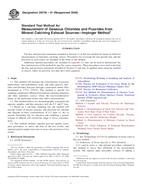
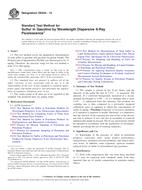 ASTM D6334-12
ASTM D6334-12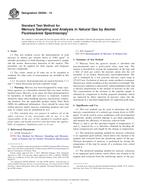 ASTM D6350-14
ASTM D6350-14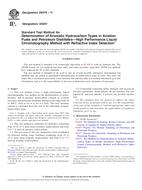 ASTM D6379-11
ASTM D6379-11 ASTM D6420-99(2010)..
ASTM D6420-99(2010)..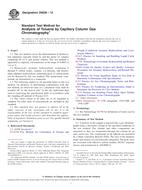 ASTM D6526-12
ASTM D6526-12 ASTM D6563-12
ASTM D6563-12
 Cookies
Cookies
